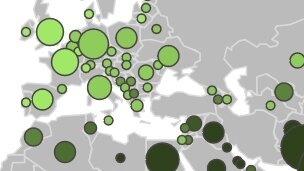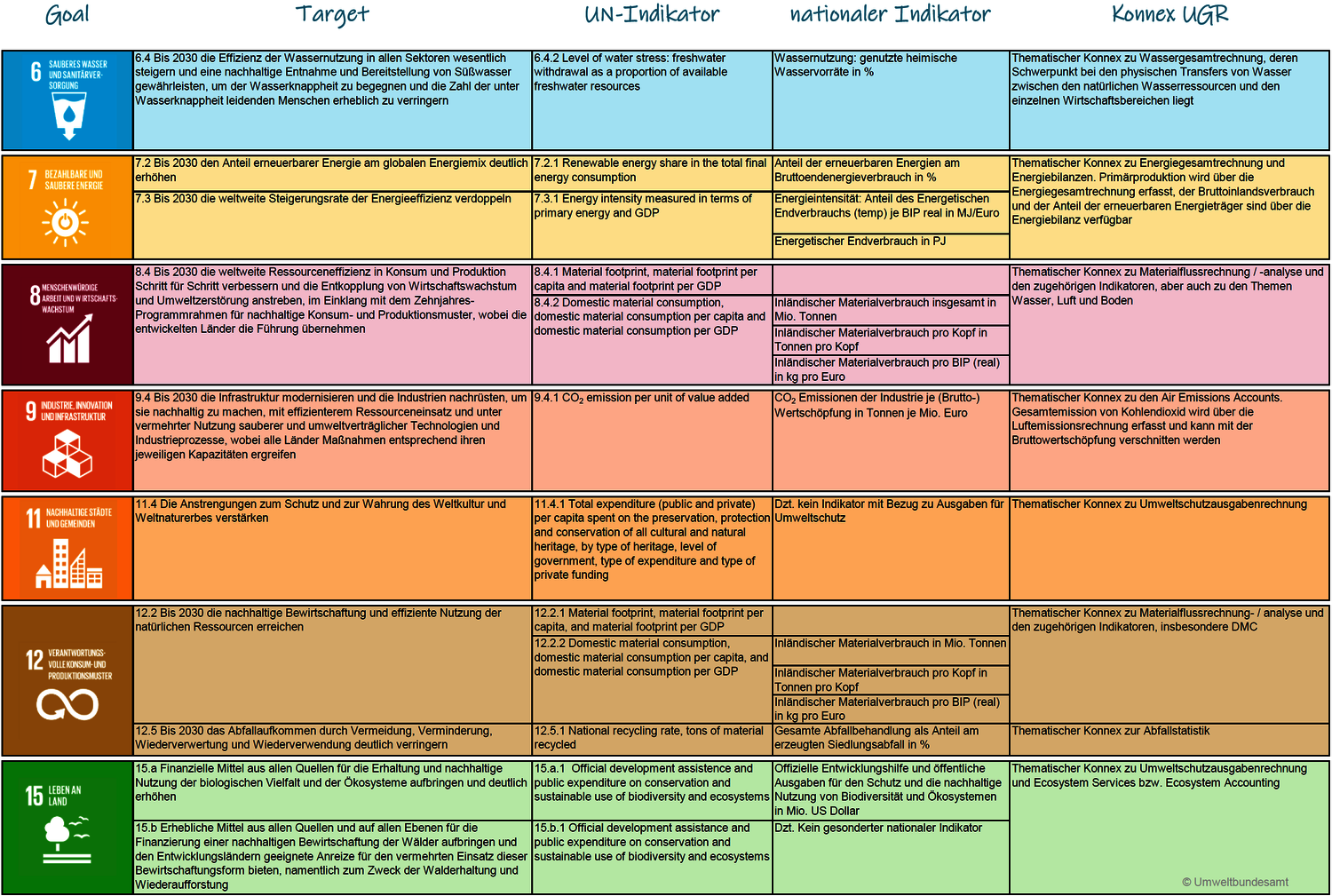Indicators
Indicators are of fundamental importance in order to record, measure and describe situations and developments in the various environmental areas. As precisely defined parameters, indicators provide information about temporal trends, risks, the effect of measures or describe progress with regard to existing goals.

The type and objective of an indicator are always determined by the question to which it is supposed to provide information and answers. This means that indicators can be available in different forms.Sometimes as tables with numerical data describing a spatial and temporal development of a parameter, or as a combination of tables and graphs from different sources to evaluate the progress towards certain goals.
Indicators are an important instrument of environmental policy, form the information basis for the development of strategies or action plans and are essential for political decisions in order to improve the environmental situation.
Indicators from the environmental accounts
Indicators collected as part of the environmental accounting modules enable a detailed examination of the interactions between the environment and society.
Environmental accounting indicators are used in various national and international indicator sets and provide information on resource efficiency and eco-taxes, among other things.
In the following, examples of national and international sets of indicators are presented in which information from environmental accounts is used.
Austria
Sustainable Development Goals (SDG) - Indicators
For the monitoring of the targets of the UN Agenda 2030 "Transformation of our world: The 2030 Agenda for Sustainable Development", sets of indicators are in use or in development at national, regional and UN level.
Statistics Austria developed an initial set of indicators for Austria in 2017, which is based on the UN indicator proposals.
This national indicator set currently contains around 200 indicators and is updated and further developed annually in cooperation with ministries and expert organizations. A national indicator report to measure and present progress in implementing the sustainable development goals is currently in progress.
The Austrian SDG indicator set contains indicators whose data base comes from the environmental accounts or which have a direct reference to data and calculations from the environmental accounts. This mainly concerns data from material flow accounting.
Details on the connection between environmental accounts and the SDG indicators can be found in the chapter on Sustainable Development Goals and environmental accounts.
How's Austria?
In the context of the project entitled "How's Austria?"Statistics Austria publishes a set of 30 key indicators and other additional indicators every year, which is intended to map the various dimensions of prosperity and progress in Austria in the best possible way. The set of indicators provides information on the three dimensions “material prosperity”, “quality of life” and “environment”, which complement the gross domestic product and thus contribute to a broader understanding of the development of prosperity in our society.
From the material flow accounts of the environmental accounts the key indicator "domestic material consumption" and, as an additional indicator, "raw material consumption" (RMC) contribute to "How's Austria?".
The data basis for the key indicator “share of environmental taxes in total tax revenue” and the two additional indicators “environmentally oriented production and services” and “environmental protection expenditure” can be found in the monetary accounts of the environmental accounts.
Germany
In Germany, environmental accounts have been an integral part of ecological and economic development strategies for some time. They are recognised as a method for assessing environmental pressures and environmental protection measures and for measuring them by using suitable indicators.
The German Federal Government has committed itself to implementing the goals of the UN Agenda 2030 at national level. This resulted in the revision of the national sustainability strategy by the Federal Government and its adoption in January 2017. The structure of the strategy takes up the 17 Sustainable Development Goals of the UN, so that all indicators of the German sustainability strategy were assigned to one of these goals. The Indicator Report 2018 of the Federal Statistical Office includes the indicators for measuring the achievement of goals of the German Sustainability Strategy. It contains detailed descriptions of all indicators, their development and status, as well as further analyzes.
All indicators of the German Sustainability Strategy are compiled by the Federal Statistical Office, which also analyzes and evaluates their development. The indicators come from different data bases, including mostly figures from official statistics, administrative data and other non-official sources. Most of the indicators are calculated from this data in the Federal Statistical Office. An essential source of the indicators of the German Sustainability Strategy are the environmental-economic accounts, which show cross-relationships between economic and ecological aspects.
In 2015, the Federal Environment Agency in Germany published a report containing the results of the research project "Green Economy: Making sustainable welfare measurable by using environmental economic accounting data". A conceptual measurement model designed for this purpose includes the six dimensions (A) environmental use and environmental damage, (B) natural capital, (C) environmentally related quality of life, (D) green economy: economic dimension and fields of action, (E) politics: framework conditions and measures and (F) background information: economic and social framework. National indicators were proposed along these dimensions on the basis of the OECD Green Growth Indicators, the data of which are partly taken from the environmental and economic accounts.
Switzerland
Indicators that have their data base in the environmental accounts are also used in various sets of indicators in Switzerland.
Corresponding indicators can be found in the indicator set of the Swiss Federal Office for the Environment (BAFU) but also in the indicator set “Green Economy”. These cover issues such as environmental protection expenditures, material flow / material footprint, environmental taxes or greenhouse gas intensity of the economy.
European Union
The UN sustainability goals, as set out in the 2030 Agenda for Sustainable Development, are also very important at the European Union level and offer a political framework for action. In coordination with its member states, the EU undertakes to promote the implementation of the 2030 Agenda and to work for a sustainable future for all.
The progress made in the implementation of the sustainability goals is monitored regularly within the EU by Eurostat.
To this end, Eurostat is coordinating the development and updating of a number of EU-specific indicators for the SDGs.In addition, Eurostat produces regular reports on the progress made in implementing the Sustainable Development Goals.
The 169 targets of the 2030 Agenda are monitored at EU level using an indicator set consisting of around 100 indicators, 42 of which are used to monitor more than one sustainability goal.
Details on the connection between environmental accounts and the SDG indicators can be found in the chapter on Sustainable Development Goals and environmental accounts.
Resource Efficiency Indicators - Resource Efficiency Scoreboard
On the subject of "natural resources", Eurostat also offers information and a set of indicators to improve understanding of the relationship between economic growth, the use of resources and the impact on the environment.
In this context, Eurostat developed the resource efficiency scoreboard with more than 30 indicators for the flagship initiative for a resource-efficient Europe in accordance with the Europe 2020 growth strategy.
Resource productivity, calculated as gross domestic product (GDP) divided by the total amount of materials consumed by an economy (domestic material consumption - DMC), acts as the lead indicator. The data for resource productivity, but also for the dashboard indicator “domestic material consumption per capita”, are derived from the data on material flow accounts collected in accordance with Regulation (EU) No. 691/2011 on European environmental accounts.
European Environment Agency
The EEA maintains a set of currently 122 environmental indicators that cover 13 different environmental issues. The indicators are classified into:
- Descriptive indicators (What’s happening?)
- Performance indicators (Does it matter? Are we reaching targets?)
- Efficiency indicators (Are we improving?)
- Policy effectiveness indicators (Are the measures working?)
- Total welfare indicators (Are we, on the whole, better off?)
Combined from the individual areas, a set of core indicators is made up, the Core Set of Indicators (CSI), which is also intended to enable the assessment of the progress of relevant environmental issues.
Many of the core indicators are integrated into other international indicator processes, such as those of the European Commission, OECD, WHO or UNECE.
In addition, the EEA indicator set, together with the Eurostat data set, is also the basis for the annual EEA Environmental Indicator Report with 29 indicators that support the monitoring of the European Union Seventh Environment Action Program.
The European environmental accounts provide the data basis for the indicators on resource productivity, environmentally-oriented goods and services production (EGSS) and environmental protection expenditures.
OECD - Organisation for Economic Co-operation and Development
The OECD has taken a leadership role in the development and publication of environmental indicators for many years. Indicator sets have been developed for a variety of areas such as green growth indicators or the OECD environment statistics indicators. These indicators also form a basis for the environmental assessment reports of the OECD member countries, the country performance reviews.

Green Growth Indicators
A link to environmental accounting can also be found in the "green growth" indicators developed by the OECD. The OECD approach to monitoring progress towards green growth focuses on economic production and consumption. It describes the interactions between the economy, natural wealth and political action.
The Green Growth indicator set consists of 26 indicators in four categories:
- environmental and resource productivity of the economy (carbon, energy and resource productivity; multifactor productivity)
- nature asset base (renewable and non-renewable natural resources; biodiversity; ecosystems; land and soil)
- environmental quality of life (exposure of humans to pollution and natural hazards; public access to environmental services and amenities)
- economic opportunities and political measures (technology and innovation; investment and financing; environmentally oriented production and services; taxes and transfers)
In the first group indicators of resource productivity e.g. material extraction (DEU - domestic extraction used) and material consumption (DMC - direct material consumption per capita and per unit GDP) can be found.
In this context, the OECD also stresses the importance of material flow analysis (MFA).
Environment at a Glance
The website of the OECD format "Environment at a Glance" offers interactive real-time access to the latest environmental data of the OECD member countries from the OECD Core Set of Environmental Indicators. The indicators provide information on the most important environmental trends in areas such as climate change, biodiversity, water, air quality or circular economy.
Environment at a Glance also uses data from environmental accounts in the areas of resource use (DMC, DMC/capita), resource productivity and material footprint (per capita).
United Nations
Sustainable Development Goals Indicators
In September 2015, the "2030 Agenda for Sustainable Development" was adopted by the UN General Assembly and the heads of state of the UN member states.
The 2030 Agenda aims to achieve a sustainable economic, social and ecological transformation of our world.
A major challenge is the monitoring of the Sustainable Development Goals - this is done through the targets assigned to the individual goals.
The UN Inter-Agency and Expert Group on SDG Indicators (IAEG-SDGs) was responsible for developing a global SDG indicator framework. The list of indicators shown there currently contains 232 different indicators that have been agreed upon and which are assigned to the 169 targets. Due to the multiple mentions of some indicators under two or three different goals, a total of 244 indicators are described in the list.
Details on linking the environmental accounts with the indicators of the SDG can be found in the Sustainable Development Goals and Environmental Accounts chapter.Sustainable Development Goals and environmental accounts.
UNSD
The UNSD Environmental Indicators apply global environmental statistics to ten different environmental issues, using data from a variety of international sources. The selection of topics and the indicators themselves were based on the current need for international statistics and the availability of internationally comparable data.
The data is supplied by national statistical authorities and ministries, among others, but UNSD does not clearly assign it to the environmental accounts as a data source.
Österreich:
Statistics Austria: SDGs (Sustainable Development Goals and Indicators)
Statistics Austria Indicators: "How's Austria?" 2021
Deutschland:
Destatis: Sustainable Development in Germany - indicator report 2018 (German)
Destatis: indicators on the environment and environmental accounting
Destatis: Environmental Accounting - indicators on environment and economy
Destatis: Indicators of the German Sustainable Development Strategy
Destatis: Platform on Indicators of the UN Sustainable Development Goals
German Environment Agency: indicator report - Data on the Environment 2017
German Environment Agency: Important Environmental Indicators
Switzerland:
FOEN - Federal Office for the Environment
BAFU Bundesamt für Umwelt: Grüne Wirtschaft - Indikatoren zu Messung der Fortschritte (German)
Europäische Union:
Eurostat: Track the EU´s progress for the SDGs
Eurostat: Sustainable Development in the European Union 2025 - SDG Indicators
Eurostat: Monitoring Framework Circular Economy
Europäische Kommission: Resource Efficiency Scoreboard
EEA European Environment Agency
OECD
Environment at a Glance Indicators
Environmental statistics, accounts and indicators
Towards Green Growth: Monitoring Progress - OECD Indicators
United Nations
UNSD - United Nations Statistics Division: Environmental Indicators

